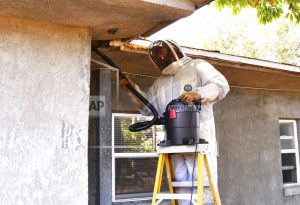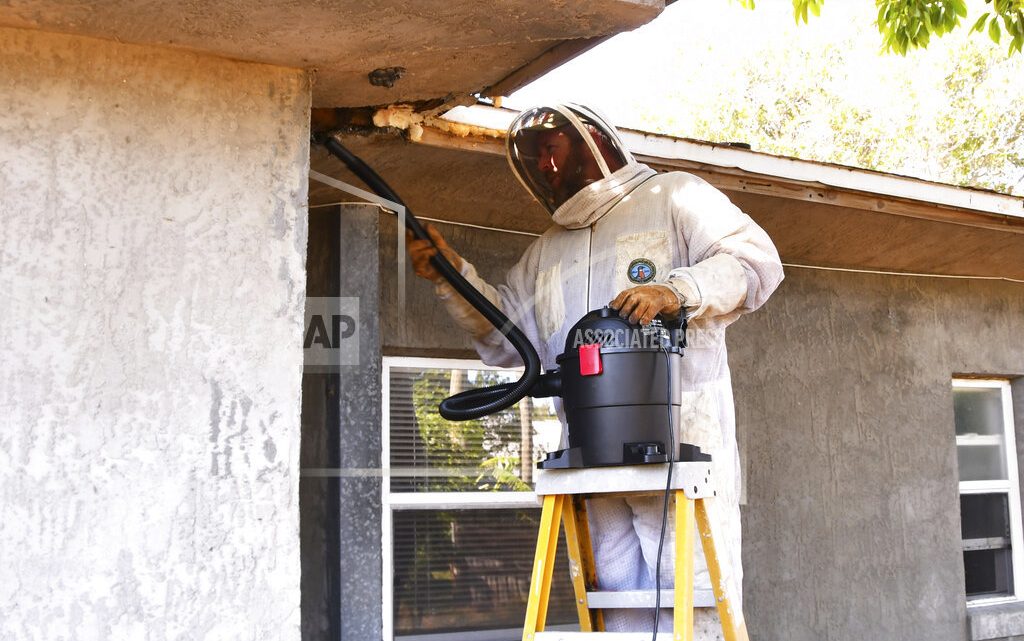Bee crisis: Pollinators endure countless threats in Florida
By JIM WAYMER Florida Today
COCOA BEACH, Fla. (AP) — Tim Gould by now is well attuned to all the buzz beneath his roof.
“I don’t know why they’re picking on me,” Gould says, as wildlife trapper Leo Cross climbs a ladder to vacuum out the beehive inside his roof. “They’ve lit me up multiple times.”
No hard feelings: Gould wants to save his tormentors. He knows their importance as pollinators for a third of what we eat. He knows Cross won’t kill them.
He knows they’re in deep trouble. And if they don’t make it, likely, neither will we.

Leo Cross with Florida Wildlife Trappers, removes bees outside a house in Cocoa Beach, Fla.. He had removed a hive of bees a week ago, but many bees returned to the area inside the homeowner’s roof so had to return a week later to remove the rest of them. (Malcolm Denemark/Florida Today via AP)
Scientists call it a “pollinator health crisis.” One in three mouthfuls of everything we eat directly or indirectly rely upon honeybee production, according to the U.S. Department of Agriculture. Pollinators contribute more than $24 billion to the American economy, $15 billion from honey bees alone.
But domestic pollinators have plummeted for decades, especially native bees, recent research shows. Managed honey bees dropped from 6 million colonies in 1947 to 2.5 million now. A phenomenon called colony collapse disorder killed 23 percent of the honey bee population after the winter of 2006-2007. Meanwhile, monarch butterflies have dipped 84 percent.
Fewer pollinators pose a serious risk to domestic crops, ecological health and the economy in Florida and nationwide, scientists warn. Like canaries in a coal mine, bees also reflect the overall health of the environment. The rapid loss of bees over the past decade may signal a decline in the health of the planet, scientists warn, and a symptom of much larger environmental problems.
But Florida’s bees, appear to be — for the moment — on the mend, beekeepers and state agricultural officials say. They continue to face a litany of threats from pests, pesticides and diseases, as well as hurricanes. But Florida has the advantage of yearly boosts from commercial beekeepers up north who bring their bees to winter here, providing a spillover effect for beekeepers like Clifton Best.
He sees first hand — without using gloves — a bee comeback in Brevard. It manifests in the daily calls he fields from fearful homeowners wanting to rid their property of unwanted bees without using pesticides to kill them.
“I’m doing so much bee removal, I don’t have time to sit still,” Best says from his 2-acre bee operation in Canaveral Groves.
Earlier this month, a Melbourne man was stung more than 100 times while trying to save his dog from a swarm of bees. He was hospitalized and recovered, but his dog died. Leo Cross, of Florida Wildlife Trappers, responded to the scene, vacuuming thousands of bees from inside the walls of the the Myrtlewood Road home.
Clifton Best’s bee haven is nestled in a remote wooded area. Through a fenced-in narrow passageway, Best keeps 50 bee colonies in wooden boxes propped up on concrete blocks among towering trees. A constant roar of bees amplifies each time Best approaches the boxes.
Nationwide, bee colonies like his are not doing so well. A 2015 USDA national survey of beekeepers found mixed trends for bee colonies. But Florida’s bee colonies grew from about 150,000 colonies in 2007 to almost 400,000 colonies in 2014. But those numbers can be misleading, scientists say, because beekeepers often split their colonies. So more colonies doesn’t necessarily mean more bees. The surveys also don’t take into account the health of the colonies.
Best credits the increase in bees he sees to state efforts to ease rules on allowing beekeepers to remove nuisance bees, mitigating others from excessive use of pesticides to rid homes of bees.
Other state actions could soon help as well. A bill is pending in the Florida Legislature to create a special “Save the Bees” license plate for the Florida State Beekeepers Association. A portion of the money would go toward raising awareness of the importance of beekeeping in Florida agriculture by funding honeybee research, education, outreach and husbandry.
___
State actions “nascent and anemic”
But state laws and policies to protect bees and other pollinators are in their infancy, researchers who study pollinators say.
In a paper published this year in the journal Environmental Science and Policy, Missouri researchers called for global monitoring and conservation agreements. They found that since 2000, 36 states have passed 109 new laws addressing beekeeping, pesticides, habitat, awareness and research. Florida wasn’t one of them.
They called state efforts, with few exceptions “nascent and anemic steps in addressing a pollinator health crisis.”
A mere nine states — Arizona, California, Connecticut, Idaho, Indiana, Maryland, Minnesota, Oregon and Vermont — have enacted legislation to protect pollinators from pesticides.
But the Missouri researchers pointed to some promising recent developments, including increased awareness and alarm about pollinator losses and the threats to food security and economic stability.
“They’re beginning to see that not all insects are pests,” said Damon Hall, an assistant professor at University of Missouri’s School of Natural Resources and lead author on the study.
While market interest and investment will likely save the honey bees, which Europeans brought here, Hall says the much bigger worry is native bees, of which there are 4,500 species in North America. “We don’t know how important native bees are to our crops,” Hall said.
In October, the National Conference of State Legislators brought attention to the issue in a report that also called on more state and federal protections for pollinators.
Several federal bills have been introduced in recent years to protect pollinators. The Saving America’s Pollinators Act of 2015 directs the U.S. Environmental Protection Agency to take actions related to pesticides, including suspending the registration of neonicotinoid pesticides, a class of nicotine-based insecticides. EPA prohibits use of certain neonicotinoid pesticides when bees are present.
“I think they need a more thorough review,” Hall said.
___
Colony Collapse Disorder baffles
Colony Collapse Disorder (CCD), which causes rapid and unexpected bee loss within a hive, continues to confuse scientists, who have proposed theories as to the cause, but nothing definitive. Scientists are studying multiple potential causes, with some suspecting it may not even be a new phenomenon. Inquiries have pointed to malnutrition, genetically modified crops, a mite that transmits viruses to bees, or some undiscovered pests or diseases.
In 2011, countless bees died for unknown reasons near Brevard’s southern border, leading some to suspect it was a case of CCD.
State agricultural investigators determined the South Brevard bees were being killed via sabotage, according to University of Florida, Institute of Food and Agricultural Sciences Extension officials. The bee’s food was spiked with a pesticide, though no charges were ever filed.
Bees can carry granular pesticides from residential landscapes back to hives, mistaking it for pollen, with deadly consequences.
So experts recommend getting a beekeeper to remove the bees.
___
County lightens up on bees, too
With emerging threats from Zika, dengue and chikungunya viruses that thrives in Florda’s extreme wet conditions, county mosquito control officials must weigh that risk with the potential harm pesticides pose to pollinators.
Brevard’s pesticide applicators are licensed in public health by state agriculture, Joseph Faella, director of Brevard County Mosquito Control, said via email.
They follow product labels and account for wind, rain, time of day, habitats, and other site conditions to prevent any inadvertent environmental impacts, he added.
When chemical spraying is a must, the county sprays at least 30 minutes after sunset, when bees and other pollinators are generally inactive, he said.
Brevard’s flooding from hurricanes and other storms resulted in an overall reduction in mosquito-control pesticide use over the past five years, Faella added.
The county captured floodwaters within 28,000 acres of lands surrounded with earthen dikes used to manage water levels in order to eliminate mosquito egg laying opportunities.
That’s one method of reducing mosquito breeding, in what’s called integrated pest management (IPM). The county also uses biological control and outreach education, first trying to get folks to eliminate water holding containers (and sometimes stock fish).
Horticulturists say maintaining diverse plant life in your backyard can help promote pollinators.
On Best’s land, bees have their pick of a diverse array of plant and tree life. They swarm around Clifton Best as he stands in front of their hive box.
“It agitates them a little bit when we get in front of their entrance,” Best says as he holds a metal can of smoking pine needles in front of the hive.
The smoke blocks the pheromones that signal them to sting an invader.
He cracks the lid open with a metal wedge. The static-like buzzing roar heightens in volume.
Best provides them with hive racks. The rest is up to them, as long as we stay out of the way.
“They don’t need us. We need them,” Best says.
___
Information from: Florida Today (Melbourne, Fla.), http://www.floridatoday.com





No Comment